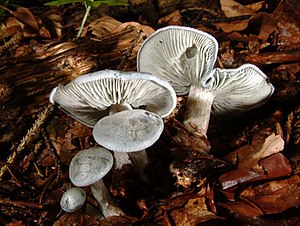Dikarya
| Dikarya | ||||||||||||
|---|---|---|---|---|---|---|---|---|---|---|---|---|

Green pineapple funnel ( Clitocybe odora ) |
||||||||||||
| Systematics | ||||||||||||
|
||||||||||||
| Scientific name | ||||||||||||
| Dikarya | ||||||||||||
| Hibbett , TY James & Vilgalys | ||||||||||||
| Departments | ||||||||||||
|
Dikarya is a sub-kingdom of fungi that was first described in 2007 to match the common characteristics of the Ascomycota and Basidiomycota with a taxon that includes these two groups.
features
The dikarya are unicellular or thread-shaped mushrooms. Flagella absent in all stages. It is characteristic of the Dikarya that they have stages in their life cycle with two cell nuclei per cell.
Systematics
The common characteristics of the tube and stand mushrooms led to the fact that they were placed in a common taxon several times. An incorrect name was Dikaryomycota. Thomas Cavalier-Smith named the group Neomycota in 1998. According to the ICBN , the ending -mycota is reserved for the department rank. James et al. called the clan Dikarya in 2006 without describing them formally. This has been shown by Hibbett, TY James & Vilgalys 2007 in Hibbet et al. made up for.
The dikarya comprises the two departments
- Ascomycota mushrooms
- Stand mushrooms (Basidiomycota)
These two groups together form a unit of descent, so they are a monophyletic taxon. Their sister group are the Glomeromycota .
A cladogram looks like this:
|
|
|
||||||||||||
|
|
literature
- DS Hibbett et al .: A higher-level phylogenetic classification of the Fungi . In: Mycological research , May 2007; 111 (5): 509-547. Epub 2007 March 13, 2007. doi : 10.1016 / j.mycres.2007.03.004 , (PDF; 1.27 MB)
Individual evidence
- ↑ a b T. Y. James et al .: Reconstructing the early evolution of Fungi using a six-gene phylogeny . In: Nature , Volume 443, October 19, 2006, pp. 818-822. doi : 10.1038 / nature05110